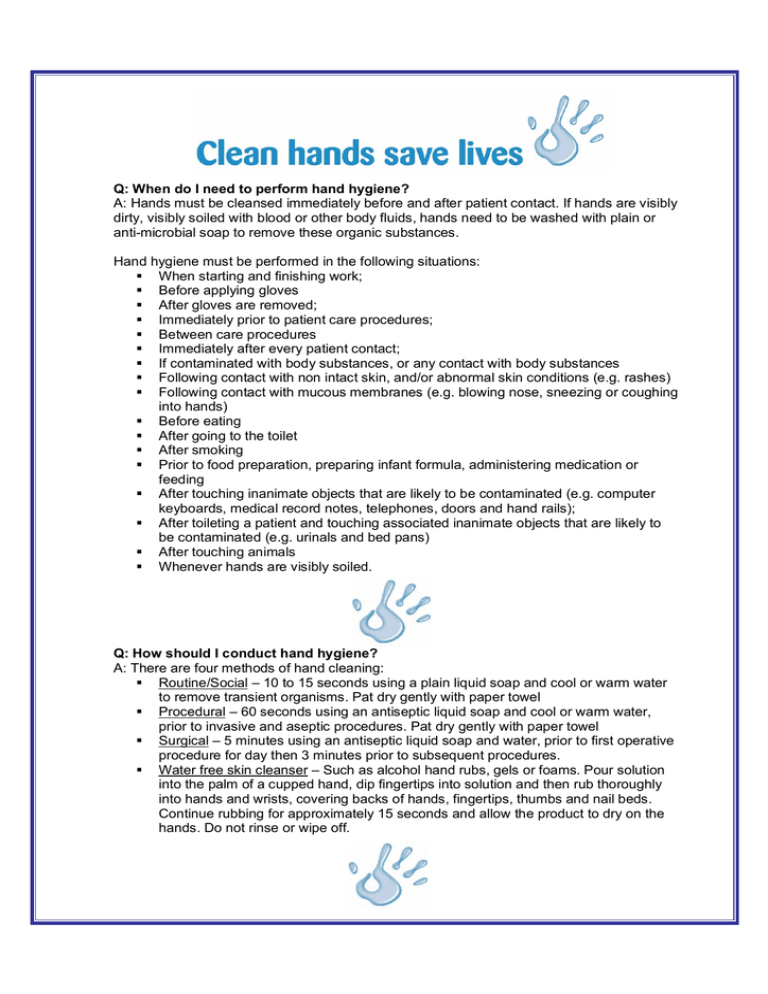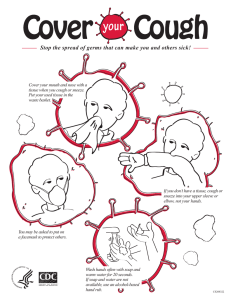Q: When do I need to perform hand hygiene? A: Hands must be
advertisement

Q: When do I need to perform hand hygiene? A: Hands must be cleansed immediately before and after patient contact. If hands are visibly dirty, visibly soiled with blood or other body fluids, hands need to be washed with plain or anti-microbial soap to remove these organic substances. Hand hygiene must be performed in the following situations: When starting and finishing work; Before applying gloves After gloves are removed; Immediately prior to patient care procedures; Between care procedures Immediately after every patient contact; If contaminated with body substances, or any contact with body substances Following contact with non intact skin, and/or abnormal skin conditions (e.g. rashes) Following contact with mucous membranes (e.g. blowing nose, sneezing or coughing into hands) Before eating After going to the toilet After smoking Prior to food preparation, preparing infant formula, administering medication or feeding After touching inanimate objects that are likely to be contaminated (e.g. computer keyboards, medical record notes, telephones, doors and hand rails); After toileting a patient and touching associated inanimate objects that are likely to be contaminated (e.g. urinals and bed pans) After touching animals Whenever hands are visibly soiled. Q: How should I conduct hand hygiene? A: There are four methods of hand cleaning: Routine/Social –10 to 15 seconds using a plain liquid soap and cool or warm water to remove transient organisms. Pat dry gently with paper towel Procedural –60 seconds using an antiseptic liquid soap and cool or warm water, prior to invasive and aseptic procedures. Pat dry gently with paper towel Surgical –5 minutes using an antiseptic liquid soap and water, prior to first operative procedure for day then 3 minutes prior to subsequent procedures. Water free skin cleanser –Such as alcohol hand rubs, gels or foams. Pour solution into the palm of a cupped hand, dip fingertips into solution and then rub thoroughly into hands and wrists, covering backs of hands, fingertips, thumbs and nail beds. Continue rubbing for approximately 15 seconds and allow the product to dry on the hands. Do not rinse or wipe off. Q: When should I use soap and water to perform hand hygiene and not an alcoholbased hand rub? A: If hands are visibly dirty, visibly soiled with blood or other body fluids, washing hands with plain or anti-microbial soap is required for removing these organic substances. The same is advised when following known or suspected exposure to clostridium Difficile. Washing with soap and water is preferred because it is the best method of physically removing spores from the hands. Alcohols, Chlorhexidine, Iodophors and other antiseptic agents have shown poor activity against spores. Q: What are the advantages to using alcohol-based hand rubs to perform hand hygiene? A: Alcohol based hand rubs require less time to perform hand hygiene when compared to regular hand washing procedures with a liquid soap and water. Pump bottles are more easily accessible than sinks and is a fast acting cleanser. Alcohol-based hand rubs are less likely to cause irritation to the skin when used repeatedly in comparison to soap and water hand washing techniques. Q: What are the advantages to alcohol chlorhexidine hand rub over alcohol hand rub? A: Regrowth of bacteria on the skin occurs slowly after use of alcohol-based hand antiseptics¹. The addition of chlorhexidine to alcohol demonstrates persistent effect for at least three hours after application and is of advantage where there is extended time between applications. Alcohol-based hand rub on its own does not have this persistence. However this does not reduce the need to perform hand hygiene before and after any direct patient care or after handling of any blood or body substance or contaminated equipment. Q: How long do micro organisms last on hands? A: In health facilities, many surfaces are often contaminated with micro organisms, and all health facility staff hands may serve as vectors for cross infection. The survival of most micro organisms on surfaces is dependant on various environmental conditions in health facilities, such as humidity, temperature, inoculum and presence of organic matter. Even taking these conditions into consideration, some micro organisms may well survive or persist on surfaced for months.² For example, Staphylococcus aureus including MRSA can persist on surfaces from 7 days to 7 months, Clostridium difficile (spores) for 5 months, Rotavirus from 6 to 60 days, E. coli from 1.5 hours to 16 months, Candida albicans from 1 to 120 days and influenza virus for 1 to 2 days. ___________________________ ¹Boyce J, Pittet D, 2002, Guideline for Hand Hygiene in Health Care Settings: Recommendations of the Health Care Infection Control Practices Advisory Committee and the HICPAC/SHEA/APIC/IDC Hand hygiene Task Force, Infection Control and Hospital Epidemiology, 23(12):S3-S41. ²Kramer A, Schwebke I, Kampf G 2006, How Long Do Nosocomial Pathogens Persist on Inanimate Surfaces? A systematic review. BMC Infectious Diseases 6:130 Th e main route of transmission of micro organisms in a health care facility is on the hands of health care workers to the patient and their associated environment. Overwhelmingly, the international and national evidence of low compliance with hand hygiene is significant. Hence the risk in not practicing hand hygiene before and after patient contact is to reduce the transient effects from contaminated surfaces to hands should not be ignored. Q: My hands are dry and cracked and sometimes they sting when I apply an alcoholbased hand rub. How do I care for my skin while performing hand hygiene? A: Stinging demonstrates pre-damaged epidermal tissue, most commonly caused by the frequent use of harsh soaps, unseen breaks in the skin and/or techniques that cause irritations by drying and damaging the skin. The use of an alcohol-based hand rub may lead to an improvement in the condition of your hands because it contains an emollient. Emollients do not remove skin lipids and do not require rinsing or wiping. In addition, when performing hand hygiene with soap and water take care to rinse thoroughly in warm or cold water, and pat dry gently - do not use hot water. It is also useful to protect hands while working at home by wearing gloves when using cleaning products and using hand creams. Q: What should I do if my skin has cuts or abrasions? A: Skin that is intact, without cuts, abrasions or lesion, is a natural defence against infection. Health care workers should cover cuts and abrasion on exposed skin with a water-resistant occlusive dressing which should be changed as necessary or when the dressing becomes soiled, loose, damp or damaged. Skin conditions or lesions on the hands of health care workers that cannot be covered with a water-resistant occlusive dressing (or gloves to protect the abrasion when procedures are conducted), should be assessed by a designated health professional and/or medical practitioner. Temporary redeployment of staff may be necessary based on the advice of the employee’ s medical practitioner or ‘ staff health’ service. Health care workers may need to have an assessment of their hands using the ‘ Hand Hygiene and Skin Sensitivity Assessment Package’ . (http://www.cec.health.nsw.gov.au/campaigns/cleanhandssavelives/documents/actioncheckl istskinsensitivity.pdf) To support hand care, liquid soap and skin cleaning solutions should be pH friendly to skin (pH 5.5-7). This will assist reduction in damage to the natural acid mantle covering the skin surface and reduce damage caused by drying of the skin that is repeatedly cleaned. Hands can be protected from chaffing by the regular use of non-oil based moisturising creams or lotions. Q: Does it matter if my hands are wet when I apply the alcohol-based hand rub? A: Yes, having wet hands dilutes the solution thus decreasing its effectiveness. It is important that the solution is applied to dry hands, rubbed thoroughly onto the entire surface of your hands including finger tips and thumbs and allowed to dry naturally. Q: Can I use my own moisturising cream that I have brought from home? A: No, many hand creams may inactivate alcohol hand rubs and antiseptic hand cleansers. The products supplied by your hospital have been chosen for their compatibility with alcohol based hand rubs and antiseptic hand cleansers. A pump pack should be used for dispensing moisturising creams or lotions. If a cream or lotion cannot be dispensed by a measured dose pump dispenser, then a single use applicator or single use spatular should be used. Q: Why do I have to decontaminate my hands after removing my gloves? A: The use of gloves does not eliminate the need for hand washing or cleaning. Hands should be washed or cleaned after removal and disposal of gloves. Gloves are worn as a barrier to protect the wearer’ s hands from decontamination or to prevent the transfer of organisms already on the hands.³ Gloves will decrease the number of micro organisms you acquire on your hands, but will not totally prevent them and cannot be guaranteed to provide complete protection against viral or bacterial contamination of the hands during glove removal. Q: Can I wear artificial nails, hand or wrist jewellery when having direct contact with patients? A: Laboratory staff and staff involved in direct patient care, sterilizing services must not wear artificial nails, nail extenders or any nail enhancements (e.g. painting, varnish or nail art). Chipped nail polish may support the growth of larger numbers of organisms on fingernails. Outbreaks have been attributed to long natural and artificial nails. Personnel wearing artificial nails also have been epidemiologically linked to several outbreaks of infections in hospitals. Natural finger nails should be less than 0.5cm long. Hand and wrist jewellery should be kept to a minimum for direct patient care. Rings with large or multiple setting or detailed scrollwork should not be worn during direct patient contact. Wrist jewellery must be removed for all invasive procedures. Wrist bands made of cloth, wood or leather than cannot be easily removed for patient activity should not be worn in the clinical environment. Studies have demonstrated that skin underneath rings is more heavily colonized with micro organisms. _________________________________________ ³New South Wales Department of Health, 2002, NSW Health Infection Control Policy, NSW Government Directive, p 11-12

